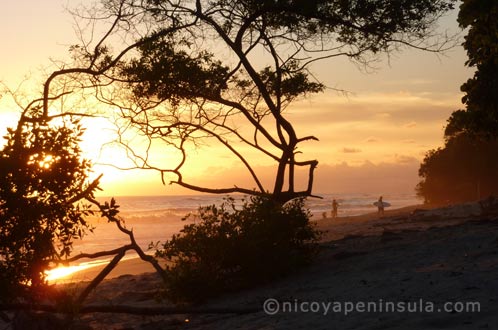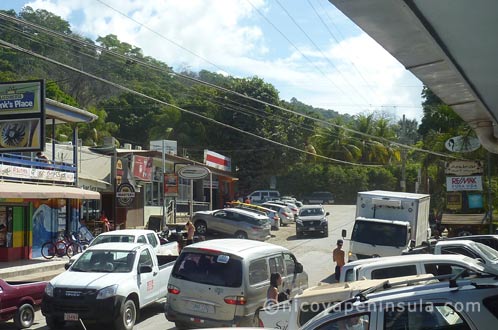Santa Teresa Costa Rica
Santa Teresa is one of Costa Rica’s most popular beach destinations, which attracts especially surfers to its long sandy beaches and great surf.

A broad strip of forest frames the beach of Santa Teresa and an absence of high-rise buildings maintains the pristine image of the coastline with its long sweep of white sand beach washed by the pacific surf and backed by jungle covered hills. Beyond the beach forest, Santa Teresa’s main street runs parallel to the coast, along a long, notoriously crowded and dusty road. » Map of Santa Teresa

The past 20 years the village has seen a huge spike in devolopment and is now a bustling tourist town. Many a tourist who just wanted to spend a surfing vacation in Costa Rica got stuck and made Santa Teresa his new home. Continuous building activities are all around and developments are gnawing more and more into the jungle of the surrounding hillsides.
A panoply of restaurants, bars, venues, and hotels have been created by the multicultural new residents. Lodging options range from low-key surf hostels to some of the most luxurious hotels and vacation rentals in Costa Rica. Compared to other Costa Rican tourist destinations Santa Teresa is more expensive and in high season it’s sometimes difficult to find a bed.
Activities in Santa Teresa

For many people surf in Santa Teresa is the main pursuit and many visitors receive their first surf lessons here. Apart from challenging surf spots for experts there are also the easy-going breaks of Playa Carmen for novice surfers. Many hotels offer surf instructions, surf camps or surf packages for different target groups.
There is however still more to do than surfing. You can make long hikes along the beaches, bathe in tidal pools or find a place under a palm tree for loafing and reading a book. For health and spirit there are lots of hotels that offer yoga classes. Other activities in Santa Teresa are horse back riding, tours to nearby attractions like the waterfalls in Montezuma, a boat and snorkeling tour to the Tortuga Islands, or a visit to Cabo Blanco, Costa Rica’s oldest nature reserve on the tip of the peninsula. Adjoining the national park is Malpais with its small fishing port. From here you can embark on a fishing tour or do paddle boarding. Near the port and Cabo Blanco is also a zip-line tour through the canopy.

When it comes time for sunset many people gather on the beach to enjoy the cool breezes, watch the surfers, and make plans for the evening. Santa Teresa offers plenty of nightlife, especially during high season, from December to March. Extreme party time, with international DJs and many events, is during the Christmas/New Year holidays.
Take care however on the beach when it gets dark. Most of the crowds quickly leave after sunset and you might better do so as well. Times are long gone since Santa Teresa was safe at night on the beach.
More:
» Santa Teresa Practical Information
» Pictures of Santa Teresa
The Beaches of Santa Teresa
Santa Teresa has no central focus. The town sprawls parallel to the coast, lined up along several miles of potholed, dusty road. Most visitors enter Santa Teresa on its southern edge, at Playa Carmen, where the perpendicular street from Cobano comes in. See: » Map of Playa Carmen.
Playa Carmen

Locals refer to the road intersection at Playa Carmen simply as “El Cruze” (the intersection). It marks the border between the community of Mal Pais to the south, and Santa Teresa to the north. From here the craziness of Santa Teresa starts with a road that is most times crammed with cars, quads, motorcycles and people.
“El Cruze” is one of Santa Teresa’s main commercial areas. Here you find a bank, pharmacy, car rentals, doctors, and a small shopping mall. A broad road leads down to the Playa Carmen parking lot and the beach with small vendors selling coconut water and souvenirs under palm trees, a wide beach with sun chairs for rent and surfers frolicking in the waves. To the south you gaze upon the rocky shoreline of Mal Pais, backed by the hills of Cabo Blanco, the very tip of the Nicoya Peninsula.
Playa Carmen is popular with sun bathers and surfers who enjoy the long beach break here. In high season you can even surf at night, when the waves are lit by flash lights. Swimming, however, on Playa Carmen and Playa Santa Teresa, is not recommended as the surf can be overwhelming.
Playa Santa Teresa

The actual Playa Santa Teresa is situated around 3 km north of Playa Carmen, past the soccer field. » Map of Playa Santa Teresa
In recent years this area has become more and more popular and many new hotels and restaurants have popped up. The beach here is a broad and long expanse of white sand edged by jungle. The surf on Playa Santa Teresa is more challenging and presents both point and beach breaks. A local landmark is the discotheque of “La Lora” with its dance and music events. Here a road descends to a small parking lot on the beach, which is a popular surfer hangout.
Santa Teresa North

Venturing further north constructions along the shoreline and parallel road become more sparse. Though the beach is rocky in several parts, it presents a picturesque coastal landscape.
3 kms past “La Lora” you pass by the “Peñon”, a sugarloaf shaped rock in the ocean. For the next 400 meters the road skirts a scenic beach where at low tide you find a large rocky tidepool that is nice for bathing and snorkeling.
Playa Hermosa
2 kms further north of the “Peñon” you arrive at a T-junction where an uphill road to the right leads to Manzanillo and on to Samara and Nosara, while a turn to the left brings you to Playa Hermosa.

Playa Hermosa, meaning Beautiful Beach, is an appropriate moniker: it is the paragon of the tropical beach, both wide and sandy, ringed by swaying palm trees and almendros. There are no underwater rocks, making it ideal for bathing and the gentle surf is easy for beginners. Be careful with swimming however, as there is often a strong current, especially on the northern part of the beach.
Playa Hermosa is Santa Teresa’s most recent boom area. Only few years ago you could often find yourself alone on its scenic wide sand beach. Nowadays however it is one of the most popular beaches of Santa Teresa and a favorite surf spot for teaching novice surfers.
North of Playa Hermosa: » Playa Manzanillo
Attention: on all beaches of Santa Teresa take care of your belongings. Never leave any valuables unattended in your car and at night don’t walk alone on the beach. More » Travel Safety
How to get there
A direct bus connects to San Jose and the international airport at 6am and 3pm. Travel time, with ferry ride included, is 5.5 hours. Another option to reach beach destinations on the Costa Rican mainland is the taxi boat to Jaco, Manuel Antonio, Dominical or Uvita. The service also includes the pick-up from your hotel in Santa Teresa.
If you will drive with your own car see: Ferry schedules and the article about Driving on the Nicoya Peninsula.